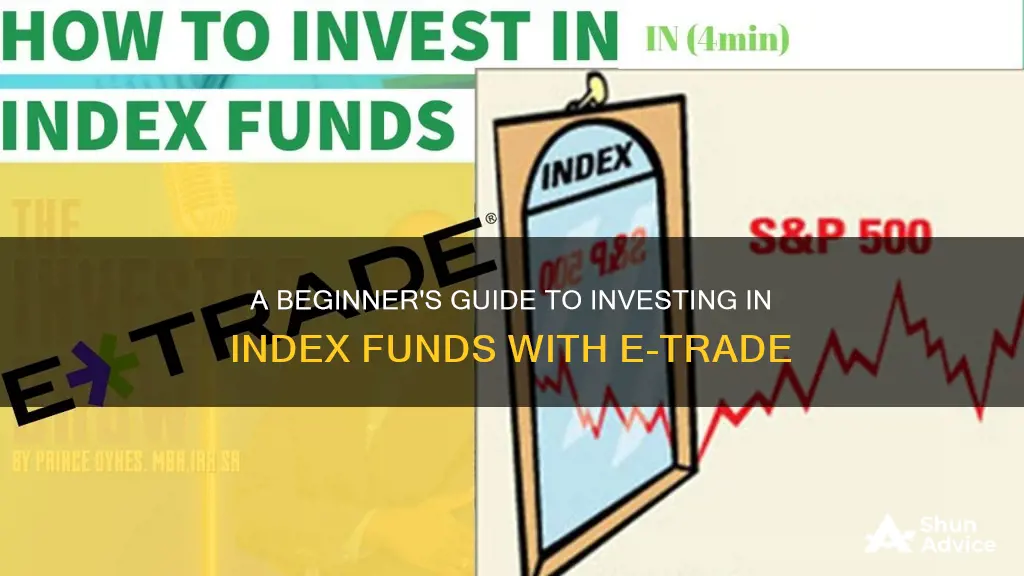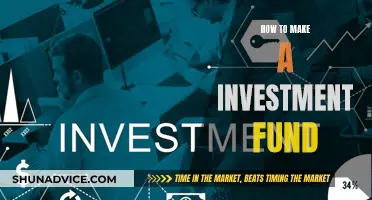
Index funds are a great way to build wealth over time, especially for retirement investors. They are a group of stocks that mirror the performance of an existing stock market index, such as the Standard & Poor's 500 index. Index funds are passively managed, meaning they don't need to actively decide which investments to buy or sell, and are considered a safe investment option. E*TRADE is an online platform that offers a range of investment options, including exchange-traded funds (ETFs) and mutual funds. While it is not clear if E*TRADE offers index funds, it does offer ETFs, which are similar to index funds in that they are also passively managed and aim to replicate the performance of a market index. This article will explore how to use E*TRADE to invest in index funds or similar investment options.
What You'll Learn

The benefits of using E*TRADE for investing in index funds
E*TRADE is a great platform for investing in index funds. Here are some of the benefits:
Low Costs and No Commissions
E*TRADE offers a wide range of investment options, including exchange-traded funds (ETFs) and mutual funds, with no commissions. This means you can buy and sell these funds without paying any service fees. ETFs are also typically lower in cost compared to actively managed funds as they require less work from fund managers.
Diversification
With E*TRADE, you can easily diversify your portfolio by investing in various types of funds, such as ETFs and mutual funds, which are baskets of individual stocks, bonds, or other assets. This diversification reduces your vulnerability to loss if a single company or industry underperforms.
Flexibility
ETFs provide trading flexibility as they can be bought and sold throughout the trading day, similar to stocks. This gives you more control over your investment strategies and allows you to react quickly to market news and overnight developments.
Ease of Use
E*TRADE's platform is user-friendly and offers a range of tools to simplify your investing journey. The ETF Screener helps you quickly find the right funds for your portfolio, while Prebuilt Portfolios offer a fast and easy way to invest in a diversified portfolio of leading mutual funds or ETFs.
Research and Insights
E*TRADE provides a wealth of knowledge and insights to help you make informed investment decisions. You can research different types of funds, learn about market trends, and consult professional analysts for guidance.
Automatic Investing
E*TRADE's Automatic Investing feature allows you to start investing with as little as $25 per recurring investment. This feature enables you to purchase shares of well-known ETFs at regular intervals and in equal amounts, helping you build your portfolio over time.
In summary, E*TRADE offers a comprehensive set of tools and resources for investing in index funds. The platform provides low-cost and diverse investment options, flexibility in trading, and valuable insights to help you make the most of your investments.
Artificial Intelligence Mutual Funds: Investing in the Future
You may want to see also

How to open an E*TRADE account
Opening an E*TRADE account is a simple process that can be done in about 10 minutes.
First, you need to choose the type of account you want. E*TRADE offers a variety of accounts, including brokerage accounts, retirement accounts, and premium savings accounts. Once you've selected the type of account you want, you can complete the online application process.
After your account is approved, you'll need to fund it. You can do this by transferring money electronically, by check, by wire transfer, or by transferring an account from another firm. Keep in mind that you may need to meet minimum deposit requirements, which can vary depending on the type of account you choose.
Once your account is funded, you can start trading within your brokerage or IRA account. E*TRADE offers a range of investment options, including stocks, ETFs, mutual funds, options, and bonds. You can use their online and mobile platforms to place trades easily.
It's important to note that E*TRADE recommends using an updated browser to ensure all features function as intended.
Tribeca Fund: A Guide to Investing Wisely
You may want to see also

The difference between E*TRADE's mutual funds and ETFs
E*TRADE offers both mutual funds and ETFs (exchange-traded funds) as investment options. Both are collections or "baskets" of individual stocks, bonds, or other investments, providing built-in diversification. However, there are some key differences between the two:
Minimum Investment:
ETFs on E*TRADE can be purchased for as little as the cost of a single share, with some starting at $20. E*TRADE also offers ETF fractional shares through Automatic Investing, with a minimum investment of $25. Mutual funds, on the other hand, typically require a minimum dollar amount, such as $100 or $1,000, to purchase a set number of shares based on the share price for that day. However, some mutual funds have a $0 minimum.
Trading and Pricing:
ETFs can be bought and sold like stocks on major exchanges throughout the day. Mutual funds, on the other hand, can only be traded once a day after the market closes. The final price for mutual fund shares is determined after the market closes, whereas ETFs are priced continuously throughout the trading day.
Investment Style:
Many ETFs are passively managed index funds, meaning they aim to mirror the performance of a market index before expenses. However, it's important to note that not all ETFs are passively managed, as many are actively managed. Mutual funds can be either actively or passively managed as well. Actively managed funds try to outperform the average returns of a market or index, while passively managed funds seek to track the returns of a market index before expenses.
Expense Ratios:
ETFs generally have lower expense ratios than mutual funds. Actively managed funds tend to have higher expense ratios due to higher operations and trading costs. However, it's worth noting that some mutual funds are index funds, which are passively managed and tend to have lower fees.
Tax Efficiency:
ETFs may offer tax advantages over mutual funds due to their creation and redemption process, which can result in fewer capital gains tax liabilities for shareholders. As passively managed portfolios, ETFs tend to realise fewer capital gains than actively managed mutual funds.
Automatic Investing:
While not specific to E*TRADE, it is generally easier to use mutual funds for automatic investing, where a predetermined amount is invested at regular intervals.
Pension Funds: Investing in the Top 100 Companies for Secure Returns
You may want to see also

How to use E*TRADE's ETF screener
E*TRADE's ETF screener is a tool that helps you quickly find the funds you're looking for. It offers a search feature and predefined investment strategies to help you find ETFs that match your investment goals.
Here's a step-by-step guide on how to use the E*TRADE ETF screener:
- Navigate to the ETF Screener: Log in to your E*TRADE account and find the ETF screener tool.
- Define your criteria: The screener allows you to set specific criteria to narrow down the list of ETFs. You can set criteria such as investment objectives, historical performance, and fees, and fund characteristics.
- Select your preferences: Choose the criteria that align with your investment goals and risk tolerance. For example, you can select "Fund Characteristics" to search for index funds. You can also specify the time period for NAV return within a category.
- View the results: Once you've defined your criteria, click "View Results" to see the ETFs that match your selections. You can then compare the options and choose the ones that best fit your portfolio.
- Review fund details: If you want to learn more about a specific fund, click on its name. This will display information about the fund's investment strategy, objectives, and other relevant details.
- Consider your choices: Evaluate the ETFs that meet your criteria and consider diversifying your portfolio by investing in a range of options.
- Make your investment: Once you've decided on the ETFs you want to invest in, you can use E*TRADE's easy-to-use trading tools to buy and sell shares.
Remember to do your research and consult professional advice before making any investment decisions. E*TRADE offers a Knowledge section and professional insights from analysts to help you make informed choices.
Unlocking Private Equity Fund Investment: A Guide
You may want to see also

How to use E*TRADE's Prebuilt Portfolios
E*TRADE's Prebuilt Portfolios are a fast and easy way to kickstart your investing journey. With $0 trading commissions (fund expenses and service fees may apply), you can choose from a range of prebuilt portfolios of leading mutual funds or exchange-traded funds (ETFs). These portfolios are designed to align with your investment strategy and risk tolerance, whether it be conservative, moderate, or aggressive.
Here's a step-by-step guide on how to use E*TRADE's Prebuilt Portfolios:
- Select your investment strategy: Choose between a conservative, moderate, or aggressive investment strategy based on your financial goals and risk tolerance.
- Choose your portfolio type: Decide if you want a collection of mutual funds or ETFs. Mutual funds offer a basket of handpicked stocks, bonds, or other investments that trade only once per day, while ETFs provide more trading flexibility as they can be traded throughout the day.
- Review your portfolio options: E*TRADE will present you with a selection of ETFs or mutual funds that match your chosen investment strategy. You can review the options and make a decision based on your preferences.
- Purchase your portfolio: With just a few clicks, you can purchase your chosen prebuilt portfolio. The minimum investment amount for mutual funds is $500, while it's $2,500 for ETFs.
- Customise your portfolio (optional): If you want to further customise your portfolio, you can buy or sell individual funds at any time.
By using E*TRADE's Prebuilt Portfolios, you can get instant diversification across leading companies like Walt Disney Co, Mastercard, Microsoft, Apple, and Procter & Gamble. This simple and quick method of investing allows you to get into the market without the hassle of building a portfolio from scratch. Remember to always review the fund's objectives, historical performance, and fees before making any investment decisions.
Factor Funds: Where to Invest Now?
You may want to see also
Frequently asked questions
Index funds are a group of stocks that mirror the performance of an existing stock market index, such as the Standard & Poor's 500 index. Index funds are passively managed and considered a safe investment strategy as they don't need to actively decide which investments to buy or sell.
First, decide on a goal for your index funds. Then, research the index funds you want to invest in, considering factors such as company size, geography, business sector, asset type, and market opportunities. Next, pick your index funds based on cost, as index funds are known for their low costs. Finally, decide where to buy your index funds—you can purchase an index fund directly from a mutual fund company or a brokerage, or you can buy exchange-traded funds (ETFs) which are like mini mutual funds that trade like stocks throughout the day.
Index funds are a low-cost, easy way to build wealth. They are also considered a safe investment strategy as they are less volatile than individual stocks. Additionally, index funds typically bring better returns over the long term and have lower fees than actively managed investments.
As with all investments, it is possible to lose money in an index fund. While index funds are considered less risky than individual stocks, there is still a chance that the value of your investment could decrease.







